Cuisine of Britain and Ireland
culinary traditions of the British Isles
British and Irish cuisine used to have a reputation for bland food such as dry roast meat with soft-boiled vegetables. However, since the 1990s, a resurgence in cuisine has led to Britain and Ireland having restaurants and chefs to match the best in the world, and there is far more international diversity of cooking styles than in most other European countries. However, it may be challenging to find consistently great local cuisine at a reasonable price than in the region's continental neighbours.
| Cuisines of Europe British & Irish • French • German (Bavarian • Franconian) Georgian • Greek • Italian • Nordic (Finnish) • Portuguese • Russian • Spanish |
Understand
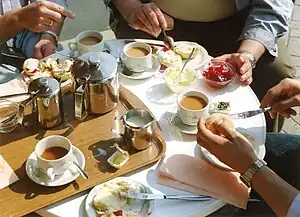
Eating out can be more expensive in Britain and Ireland than it is in the Mediterranean parts of Europe, but food in Britain is still cheaper than in the Nordic countries and Switzerland. Many large shops, especially department stores, will have a coffee shop or restaurant. Many large supermarket outlets will also have a coffee-shop, at the budget to mid-range.
If all else fails, decent picnic foods such as sandwiches, cakes, crisps, fresh fruit, cheeses and drinks are readily available at supermarkets. Street markets are a good place to pick up fresh fruit and local cheeses at bargain prices. Bakeries (e.g. Greggs) and supermarkets (e.g. Tesco, Sainsburys, Waitrose, Morrisons and Asda) usually sell a good selection of pre-packed sandwiches, pasties and cakes along with a range of soft drinks, fruit juices and mineral waters. In addition, many newsagents and some chemists will have a basic supply of pre-packaged sandwiches and bottled drinks.
Smoking is now banned in all restaurants, cafés, bars and pubs - there are no exceptions. However some establishments have provided outdoor 'smoking areas' and smoking is allowed in the gardens/terraces outside pubs and restaurants unless otherwise stated.
With heritage of the British Empire and immigration to the British Isles, these isles have a high presence of ethnic food from all around the world; especially, Middle Eastern cuisine, South Asian cuisine and American fast food are ubiquitous. Due to the former colonial ties to Hong Kong and the overseas Chinese communities in Malaysia and Singapore, there is also no shortage of authentic Chinese cuisine in the major cities.
Foods
Apples
Apples have been cultivated in the British Isles for at least two millennia, and it is claimed some grew in the wild as far back as the Neolithic (late Stone Age). It would be missing out not to sample one of the several local apple varieties grown in the region. Supermarkets tend to have only a selection of a few mass-cultivated varieties, so for a unique experience, try asking around for local producers or visit a farmer's market. New season apples appear in the shops in mid-August - the sweet variety "Discovery" is usually one of the first and is only available for a few weeks, followed by some other seasonal varieties like "Worcester". Main crop apples such as "Cox", "Russett" and "Braeburn" are in the shops from late September until the spring, after which most apples in the shops are imported. To see a large variety of apples in an orchard, visit the Brogdale National Fruit Collection, in Faversham, England.
Apples are also used in cooking, apple pie being a well known dessert item. Apples are also established in cider-making, which in the British context refers to alcoholic drinks (what Americans would know as 'hard cider').
Berries
Locally grown strawberries and raspberries were traditionally available for a few weeks in summer. Now they are grown in poly tunnels and strawberries are available from April to October, and raspberries from June to August. Imported berries are available for the rest of the year, but these often have less flavour. Commercial blackberries (brambles) are available in the summer, but you may be able to pick wild blackberries from a hedgerow in September or October.
Cheeses
- See also: Cheese#England
Although the British are not as famous for, or as proud of, their cheeses as their neighbours in France, a multitude of cheeses are produced and are generally named after a particular region. According to the British Cheese Board, there are over 700 varieties of cheeses produced in the UK. Well-known examples include Caerphilly; Cheddar, named after the village of Cheddar in Somerset; Cheshire; Lancashire, which may be "creamy" or "crumbly"; Stilton (named after Stilton but now produced elsewhere) - a blue cheese to rival Roquefort or Gorgonzola; and Wensleydale, named after a valley in North Yorkshire. A fuller list of regional cheeses can be viewed in the form of an interesting map . The quality of cheeses varies tremendously, depending on where they are bought; the best place is probably a local market, so you might want to buy your Lancashire cheese in Lancashire. Supermarkets will offer a wide range of cheeses, but these are often of inferior quality.
Fish and chips
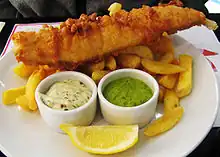
Deep-fried, golden battered fish served with a mountain of rather thick chips: one dish that nearly every visitor wants to try. The fish is most commonly cod or haddock, though plaice, hake, sole, roe, rock (salmon) and even skate are regionally popular. The chips should always be made from real chunks of potato, and are typically rough cut. Fish and chips are often dressed with salt and malt vinegar, with the option of adding ketchup, tartare sauce, or other condiments such as 'chippy sauce' (a mix of brown sauce and vinegar). You can also add mushy peas, curry sauce, gravy or baked beans to the order, among other things.
Authentic fish and chips can be bought only from a dedicated fish and chip shop, commonly known as a chippy. There is at least one of these in practically every city, town and village in the country. Chip shops are usually near where people live, and can be most often spotted by an illuminated 3D fish sign. Their names are either punning and piscine, such as New Cod on the Block, Rock 'n' Sole or The Codfather, or proud and proprietorial, like Fred's Chippy. Some can even be both as in Jack's Golden Plaice. The best chippies are specialists, serving perhaps a few alternatives such as scampi, a selection of pies, or sausages. Chip shops which cook completely unrelated foods like kebabs, burgers or Chinese food generally serve nothing worth eating. The quality of fish and chips served in pubs and restaurants can be either very good or dreadful, but in very general terms, nothing beats what a dedicated chippy can produce.
The vast majority of chippies are takeaway only, and give you the food "open" (i.e. ready to eat straight away) or "wrapped" (i.e. in paper, for transport elsewhere), accompanied with a little wooden or plastic spork. A classic British seaside activity is to take your wrapped fish and chips to a bench overlooking the beach and enjoy your meal with the wind in your hair and the smell of the sea in your nostrils. There is something particularly satisfying about eating your "fish supper" out of paper in the open air. Beware of hungry seagulls.
By contrast, a sit down chippy is a chip shop with a dining room. These are mostly found at the seaside and in tourist traps; be wary of the latter. Harry Ramsdens is a decent enough national chain of fish and chip restaurants, but you could probably do better. A stereotypical sit down chippy is brightly lit and decorated in a nautical theme with yellow or blue formica-topped tables and a shiny plastic table cloth. Here, you have the advantage of waiter service, and being able to eat your food with a knife and fork off a plate in the warmth and dry and a guaranteed gull-free zone.
Anglo-Indian cuisine
India was once the "Jewel in the Crown" of the British Empire, and Britons have embraced Indian cuisine to such a degree that curries are considered a British food. Indeed, it is widely believed that chicken tikka masala was invented by the chef of an Indian restaurant in Glasgow, Scotland, though like many origin stories, this is disputed. What's much less disputed is that most towns of sufficient size have at least one curry house, and the standard of Indian food is often quite high and authentic.
Indian restaurants serve cuisine commonly known to their customers by the generic term "curry". Common Indian restaurant dishes include chicken tikka masala, prawn biryani and the incredibly spicy vindaloo. A popular version of curry is known as balti, possibly named after the metal bowl the food is cooked and served in. Balti cuisine, and a number of other commonly served dishes such as the ubiquitous chicken tikka masala, originated in the UK, although are clearly based on food from the Indian subcontinent. Birmingham in the Midlands is considered the balti capital of the UK as this dish was conceived there. Curry Mile in Manchester is well worth a visit if you are in the city.
Cream tea
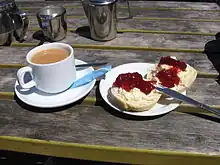
Cream tea is a fruit scone served with clotted cream (cream thickened by a gentle cooking process, produced in the counties of Cornwall and Devon) with strawberry jam and a cup of milky tea. Authentic versions can be challenging to find outside of South West England, but would always make for a mid-afternoon treat.
The Roast
Traditionally eaten on a Sunday, this meal consists of a roasted joint of meat (e.g. whole roast chicken, leg of lamb, shoulder of pork, etc.), roast potatoes (sometimes called roasties) and steamed/boiled vegetables. All served with gravy, which is a thick or thin sauce, depending on the meat, made with the meat juices and stock. Yorkshire puddings (a pancake-style batter baked in a very hot oven) are traditionally served with roast beef, although some people have it with any roast dinner. Most mid-range restaurants and pubs that that specialise in British food will have some kind of roast option, although it may be limited to certain days of the week.
Regional specialities
Ireland
- Seafood Chowder, Irish seafood soup, a must; every restaurant has their own recipe, delicious!
- Guinness Bread, like it says in the title, a brown bread which is sweet
- Oysters, try the Atlantic and Pacific types
- Boxty, potato pancakes
- Champ, mashed potatoes with spring onions
- Coddle, a stew of potatoes, pork sausages and bacon; a speciality of Dublin
- Colcannon, mashed potatoes and cabbage
- Irish breakfast, a famously filling spread of bacon, eggs, fried tomato, sausages and white and/or black pudding, a type of pork sausage made with blood (black) or without (white). Irish Breakfast is often just referred to as a "fry" or fry up, and is usually available well past normal breakfast times in restaurants.
- Mixed Grill. Similar to the Irish Breakfast, but with added lamb chop, pork chop, steak, chips, and peas
- Irish stew, a stew of lamb and potatoes, with carrots, celery and onions in a rich broth full of flavour
- Bacon and Cabbage, popular and traditional meal in rural Ireland, found on many menus
- Seafood Pie, a traditional dish of chunky fish pieces topped with mashed potato and melted cheese
United Kingdom
- Black pudding - a sausage made of congealed pig's blood or, in the Western Isles of Scotland, sheep's blood, rusks and sage or spices, cooked in an intestine. Available all over the UK but a speciality of the northern half of the country, in particular from Bury, the Black Country, Scotland and Northern Ireland. It tastes much better than it sounds. White pudding is a less common similar sausage containing oatmeal and fat - fruit pudding contains oatmeal flour, fat and raisins.
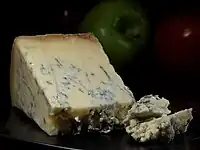
- Cornish pasty - beef and vegetables baked in a folded pastry case. Originally a speciality of Cornwall, but now available throughout the UK. Usually very good in Devon and Cornwall, but can be of variable quality elsewhere. The variety sold in a plastic wrapper in places like filling stations and motorway service stations are well worth avoiding. Cornish pasties can only be labelled as Cornish if they are made in Cornwall.
- Deep fried Mars bar - Originally from Stonehaven, Kincardineshire, but now available in other parts of Scotland and sometimes by request in fish & chip shops elsewhere in the UK. Not usually available in south-east England, where they are sometimes believed to be an urban myth.
- Eccles cake - a popular flaky-pastry type cake with raisins, from the small town in Lancashire of the same name.
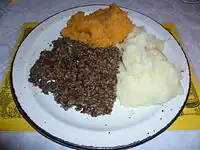
- Haggis - a mixture of sheep innards, minced meat and oatmeal boiled in a sheep's stomach. Available widely, but a speciality of Scotland. Also available in many supermarkets, where it appears that many sheep have plastic stomachs - although the contents are often quite reasonable - sometimes mildly spicy. It is usually served with mashed yellow turnip "neeps" and mashed potatoes "tatties", but can also be bought deep fried with chips from Scottish fish and chip shops.
- Hot cross bun - a spiced bread with raisins, marked with a cross on the top. Traditionally eaten for Good Friday, but also available at other times in some British departmental stores like Marks & Spencer.
- Lancashire hotpot - a hearty vegetable and meat stew. A speciality of Lancashire, but available throughout the UK. In Lancashire, it is often accompanied by pickled red cabbage or pickled beetroot.
- Laverbread (Welsh: bara lafwr or bara lawr) - a purée made from seaweed, rolled in oatmeal, lightly fried and generally served with bacon rashers, although it can also be prepared as a vegetarian dish. Available in Swansea and West Wales.
- Kendal Mint Cake - A confectionery item, originally from Kendal, consisting of sugar, glucose, water and peppermint oil. Widely used by hikers as an energy source.
- Marmite - a spread for toast or crackers, similar to Australia's Vegemite. Its strong, yeasty flavour draws polarised reactions – you either love it or you hate it.
- Oatcakes - this speciality of Stoke-on-Trent, North Staffordshire and Derbyshire is a large, floppy, oat-based pancake, eaten hot, in place of bread at breakfast time, or with a savoury filling. Not to be confused with the Scottish oatcake, a sort of biscuit.
- The pastie peculiar to Northern Ireland should not be confused with the type of pasty associated with Cornwall and common throughout Britain. Recipes vary, but generally a pastie is minced pork with onions, potato and spices, shaped into a thick disc, covered with batter and deep fried. Pasties are unique to Northern Ireland and well worth trying from a fish and chip shop.
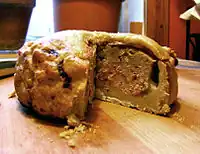
- Pork pie - a pie made of pork, with an outer crust made of a particularly crispy sort of pastry. Melton Mowbray in Leicestershire is their spiritual home but they are available across the country. They are served cold or at room temperature as part of a cold meal.
- Potato bread - a mixture of potatoes, salt, butter and flour. A speciality of Northern Ireland which, alongside sodabread forms one of the main ingredients of an 'Ulster Fry'. Similar to, but not quite the same as potato bread, are potato cakes as sold in England and tattie scones in Scotland.
- Sausages - Europeans will be surprised to discover that the filling contains breadcrumbs, rusk or other fillers as well as meat (Britons think of frankfurters and similar solid-meat sausages as German or French). Generic sausages are nothing special and very much a 'mystery meat' experience, that being said not all sausages are pork, with many now seeing a mix with beef, venison, turkey or even soya. Regional speciality recipes such as Lincolnshire and the Cumberland-ring are well worth trying in a pub. Some marketplaces and butchers still serve archaic family recipes, such as Oxford where the sausage is without skin and more like a beef patty. Remember you get what you pay for: budget 10p 'bargain' bangers from the local supermarket will taste of very little. A classic British dish using sausages is bangers and mash, which is sausages served with mashed potatoes.
- Scones - Traditionally a speciality of Devon and Cornwall, though widely available throughout the UK in modern times, and an essential part of Devonshire and Cornish tea. Typically served with jam and clotted cream.
- Soup - is sometimes offered as a starter on restaurant menus, and is more common at lunchtime, where it may be eaten with bread as a light lunch. The "brown Windsor" soup of traveller folklore disappeared from menus in the 1970s and the similar oxtail soup is also rarely seen. Soup in restaurants is often suitable for vegetarians; it's worth asking. Some cafes and restaurants will have a selection of soup options, whilst others may rotate their "Soup of Day" option, based on availability of ingredients. Supermarkets stock a wide range of ready made soups, both fresh in the fridge and in tins on the shelves.
- Sunday dinner/Roast dinner - this meal is common throughout the UK. Traditionally eaten on a Sunday, the meal consists of a roasted joint of meat (e.g.: Whole roast chicken, leg of lamb, shoulder of pork, etc.), and roast potatoes and steamed/boiled vegetables. All served with gravy (a thick or thin sauce, depending on the meat, made with the meat juices and stock. Yorkshire Pudding (a pancake-style batter baked in a very hot oven) is traditionally served with roast beef, although some people have it with any roast dinner.
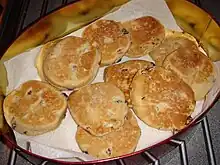
- Smoked fish - Various fish are smoked around Britain and Ireland, but there are some regional specialities. "Smoked fish" (haddock or cod) is protected as a regional dish from the greater Grimsby area. Arbroath smokies are a protected regional form of smoked haddock from north east Scotland. In Scotland, it is traditional to have kippers (smoked herring) for breakfast. Smoked salmon (and trout) is widely available and is generally made from Scottish farmed salmon.
- Welsh cakes - scone-like cakes studded with currants and dusted with sugar. Available in bakeries throughout Wales and served hot off the griddle at Swansea Market.
- Yorkshire puddings (sometimes called Yorkshires) - a savoury side dish made from unsweetened batter. Traditionally a plate-sized pudding would be served with gravy before the main course, to encourage more economical consumption of expensive meat. Squat and round in shape - often served with a roast dinner (consisting of roast potatoes, roast beef and Yorkshire puddings). Originally a speciality of the former industrial cities of Yorkshire, but now an integral part of a beef dinner throughout the UK.
Meals
Nobody is going to eat all or most of the possible meals in a day. This is just a list of what might be on offer during the day.
Breakfast
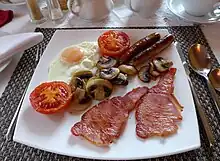
Hotels generally offer breakfast between 7AM and 10AM
A "full English, Irish, Scottish or Welsh breakfast" can include a glass of fruit juice, porridge or breakfast cereal with milk, a hot dish of bacon with a fried egg and a grilled tomato and maybe mushrooms, baked beans or black pudding, and toast with tea or coffee to finish. If you add all the options, this "Full Monty" of a breakfast, can easily set you up for the day and is a lot more than most people eat at home.
A "continental breakfast" in comparison, can encompass cereal, fruit, yoghurt, toast and Danish or French pastries, accompanied by a glass of fruit juice and tea or coffee, but some places offer a much smaller selection if it is included in the room rate.
Morning coffee
If you are visiting an office, you are likely to be offered coffee around 10AM.
Lunch
Lunch is generally eaten between noon and 2PM, although restaurants may offer lunch for slightly longer.
Afternoon tea
Britain has had a longstanding relationship with tea as a beverage. An afternoon tea, however, is a more formal and elaborate experience offered by many upmarket hotels and cafés, usually served between 3PM and 5PM, which comprises a pot of tea to a blend of your choice, poured into china cups and served with dainty sandwiches with the crusts cut off, finger cakes and patisseries, and of course fruit scones with clotted cream and jam. Your food will arrive on a stacked metal stand, with three tiered platters containing each course of the meal. To this can be added a glass of champagne or some other alcoholic beverage, for those who really want to indulge in luxury. If this sounds like a lot of food and drink, that's because it is; afternoon tea will typically replace lunch, and you may not feel like your dinner until much later on! For a formal afternoon tea in a classier hotel, you can expect full waiter service. The price range can vary considerably, and certain venues require a booking for afternoon tea in advance. Well-known places to take tea include the Adelphi Hotel in Liverpool, Betty's Café in Harrogate, the Balmoral Hotel in Edinburgh and the Ritz and Savoy in London. Outside Britain, afternoon tea is also often served in grand old hotels in many former British colonies, with Hong Kong's Peninsula Hotel, New York City's Plaza Hotel, Melbourne's Hotel Windsor and Singapore's Raffles Hotel being some of the more famous places.
However, if you are visiting a home or office you may be offered a much simpler afternoon tea of a cup of tea and a biscuit.
High tea
In Scotland and northern England, high tea is an early evening meal eaten around 6PM starting with a fairly simple hot dish such as a pie with vegetables followed by bread and cakes with loads of hot tea.
Dinner
Most people eat their main meal in the evening and call this dinner, but "dinner" may refer to lunch when this is the main meal of the day, in which case the evening meal is referred to as "supper". Dinner is generally eaten between 6:30PM and 8:30PM, although there is some regional variation in times, with dinner in southern England sometimes being later. In rural areas last orders for dinner may be at 8PM or earlier.
Where to eat
In all but the smallest village, you will usually have a choice of places to eat. Almost everywhere in the UK that sells food should have been inspected for food safety and cleanliness and the results are published - you can check up on a place by looking at the scores on the doors database (but this lists many places not open to the public).
As you go up the price range, it's more likely you may need to make prior reservations or will encounter dress codes.
Takeaways
.jpg.webp)
Takeaways are places that sell hot food to eat away from the premises, sometimes by people standing on the pavement nearby. These can be useful on a sunny summer evening if there is a nearby park.
Fish and chip shops are one of the more common takeaways. Usually these have a selection of two or three types of fried fish and a variety of generally cheaper fried alternatives, such as chicken, smoked sausage, cod roe or battered black pudding. On Friday and Saturday nights, chippies can get busy around 11PM with people buying chips on the way home from the pub. Indian, Chinese and pizza takeaways are also common, but quality can vary greatly - ask locally or look for queues.
Not all takeaway venues are in fixed venues though, some areas having nominally mobile "burger vans", which can provide a few basic fast food style items. Despite the urban folklore attached to them, it's certainly an experience getting a grill fresh, 'bacon bap' from one.
Fast food
The international chains McDonald's, Burger King, KFC, and Subway can be found in many town centres. The likes of Five Guys, Taco Bell and Tim Hortons have experienced growth around the UK in the early 2020s. Pret a Manger, or Pret for short, is a UK-based sandwich shop that has grown internationally.
Cafes
Cafes are usually open only in the daytime. Some may be open at 6AM, serving breakfast, but closing at 2PM. Others open at 9AM and close at 5PM. They are generally independent small businesses, and vary greatly in the quality and range of food offered. Cafes are usually not licensed to sell alcohol.
A common menu item is the "all day breakfast". This is similar to the main course of a full breakfast - bacon, sausage, fried egg, mushrooms, tomato and baked beans - if there is room on the plate, chips may also be served. If you are less hungry, have a bacon roll or a sausage in a roll (a hot sausage in a bread roll, distinct from a sausage roll which is sausage-meat wrapped in pastry).
At lunchtime there is usually a selection of hot main courses, soup and freshly made sandwiches. Tea, coffee and freshly baked biscuits and cakes are usually available all day. You might also find flapjacks: simple, sweet pastries made from oats.
The National Trust operates cafes at many of its rural properties. Although these are not cheap, they are good quality and the profits go towards maintaining the heritage that you are visiting. Rural garden centres often have good cafes.
Some independent cafes in tourist areas are also linked with ice-cream parlours, with 'gelato' potentially being available alongside the espresso.
Pubs
Some pubs offer a hot food menu. The kitchen often closes much earlier than the bar. Children may be allowed in the pub during some of the hours when food is served.
A good independent "free house" pub is generally the best choice. However, there are several chains of pubs which can provide dependable, if unexciting, food, including Beefeater, Greene King, Hungry Horse and Wetherspoon. These options may be preferable for travellers with dietary restrictions, as their standardised menus let travellers who need gluten-free or vegetarian/vegan meals to know their options in advance.
Casual dining chains
Since the late 1990s there has been a large expansion in the number of chain restaurants offering meals around £10-25. Although the number has passed its peak, you will find a wide selection in most large towns.
- Café Rouge is a chain of French style restaurants.
- Frankie & Benny's is a chain of Italian-American restaurants, popular with families.
- Harvester is a restaurant with a wide selection of food famous for its "unlimited salad".
- Nando's specialises in spicy Afro-Portuguese chicken dishes.
- Pizza Express not surprisingly sells pizza.
- Prezzo is a chain of Italian restaurants.
- Wagamama is a chain of Japanese-inspired restaurants.
- Zizzi is a chain of Italian restaurants.
Restaurants
Hotels
In rural areas the local hotel is often a good choice for dinner. In some places it is the only choice for a sit down hot meal.
On the road
Unlike some regions, Motorway Service areas in the United Kingdom are of varied quality when it comes to food, with some having a reputation for being expensive, even if they are supposed to provide some services 24 hours a day. Most service areas feature food court style layouts with coffee or fast food options. Options for more interesting cuisine are typically available in towns within a few miles of a junction. An exception to this is Tebay Services, which has an "independent" farm shop, in contrast to the chain outlets in most other service areas.
Many petrol stations also have convenience store type outlets, which sell soft drinks, crisps (chips in the US) and other confectionery items. Some may also sell a selection of pies and pasties.
Drinks
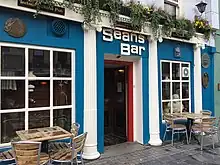
Pubs
The pub concept is distinct from the broader concept of a "bar". There are similarities shared by "pubs" throughout Britain and Ireland not shared with other sorts of drinking establishments elsewhere, though the Irish pub experience can be distinct from the pub experience of elsewhere in these islands. Chain pubs are ubiquitous, but venturing into an independent is likely to produce a wealth of regional beers and ciders, and an interesting collection of spirits, depending on the landlord's passion. Before the advent of cars and aeroplanes, pubs primarily existed to cater to travellers from afar, and were required to serve food and provide accommodation at any time in the night. In some rural towns, the pub may be your only option for a meal.
In almost all pubs, order drinks (and food) at the bar. Service at your table is rare. Gastropubs have really taken off, serving good quality seasonal British traditional food (and always gourmet burgers) in a family friendly environment, usually with table service, and a good range of alcohol. In decent weather, some have outdoor sections.
Although the pub scene has improved markedly in the 21st century the visitor would be well warned to avoid certain pubs in city centre locations, often adjacent to night clubs, on Thursday, Friday and Saturday nights, especially in provincial towns. There is a problem throughout the country of young people getting exceedingly drunk, aggressive, and very unpleasant on these evenings. Some pubs, like clubs, have bouncers, or door staff, to combat this problem but street brawls can erupt on any evening when the pubs or clubs close for the night. A certain amount of streetwise is needed, and visitors might be vulnerable. Your hotel staff will know which areas for you to avoid.
Ale and bitter
Britain and Ireland make excellent beers, not only ales but also bitter beers, which are usually not that bitter but can present quite an interesting combination of tastes. Don't be surprised if the Guinness you order tastes far better in Ireland or the UK than it does at home, as how you store the ale and how and how often your pub's taps are cleaned matters. However, some of the best ales and bitters are local favourites you probably never heard of. Ask locals for recommendations.
Cider and Perry
Although Britain is known for beer, there is a sizeable cider (alcoholic fermented apple drink) culture in West England & Ireland. It is consumed in pint glasses the same way as beer, and has a dry sharp taste. Be careful because the level of alcohol is far higher than 'normal' beer, especially if it's "West Country scrumpy". Americans should be aware that "cider" in the UK is always alcoholic, even if it doesn't taste like it: the term "hard cider" doesn't exist and its non-hard counterpart is simply known as "apple juice", which is sometimes "cloudy apple juice" for the fancy variety.
Related is Perry (aka pear cider), made from pears instead. Traditional perry can be hard to find, but the availability of commercial pear cider has increased.
Wine
Wine from throughout the world is available. This can provide a good chance to compare the same grape variety grown in France, Australia and California.
A small selection of mainly white wine is made in the south of England from locally grown grapes. This is a mid-range product, not to be confused with the inferior wine made in the UK from imported grape juice.
Spirits
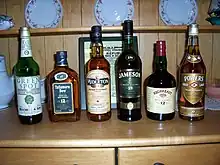
Bars will typically have a wide range of spirits available, and even a small pub, or "licensed" restaurant will have a modest selection. Spirits by the glass are generally sold in fixed measures.
Don't ask for "Scotch"; there are several brands that could be so described. Instead ask for a recommended brand, or look at what's on the optics behind the bar. (A "Scotch" in the north of England could mean "Best Scotch" beer.) Some upmarket bars even go as far as having a "whisky" list, the way restaurants have a wine list.
In the twenty-first century gin has regained its former popularity. Many small gin distilleries have opened, and some new whisky distilleries start out by making gin (which can be sold much sooner after distillation than whisky). Many of these "new" gins use novel botanical ingredients as flavourings.
Scotland has a long tradition of distilling whisky. In 2017 there were 126 whisky distilleries. Many of the distilleries offer tours, usually followed by a sample or two. Locals either drink cheaper blends (a mixture of malt and grain whisky) or a "single malt" from one distillery - the premium blends seen overseas are not popular here. A 70 cl bottle of a blended whisky can be bought in a supermarket from around £15, single malts are generally £25-40.
Ireland also has a long tradition of whiskey and had 18 distilleries in 2017, and some distilleries offer tours.
Since 2000, six small whisky distilleries have opened in England and two in Wales.
Non-alcoholic drinks
Tea is widely drunk in the UK. Most British people drink black tea with milk and/or sugar (called "English breakfast tea" when distinguished from other blends), although dozens of varieties of black, green, fruit and herbal teas are also available. Britain and tea have a long relationship. Whilst some old-fashioned budget venues still only serve breakfast tea, most cafés and tea rooms have a decent selection; popular blends include Earl Grey, peppermint, lemon, ginger, and camomile. Herbal teas are also available, and lemon may also be offered as on alternative to milk. Tea is mainly sold in teabags, however loose tea can also be purchased. Tea is always served hot and is normally heated in a kettle. Iced tea is almost unknown.
Coffee is also popular in the UK, and in some popularity polls it has beaten tea. Starbucks has a number of branches in the UK, although it has strong competition from other chains like Costa, and numerous independent coffee shops.
An unusual 'drink' more akin to soup is Bovril, offered by a small number of independent outlets. Bovril is a meat paste, which is sold in jars - to make a drink mix a teaspoonful of Bovril with boiling water.
Mineral waters are also on sale in most mid-range restaurants, with supermarkets also selling a range. The range can vary from expensive imported premium brands such as Perrier, through locally bottled waters such as Highland Spring, Buxton Water, amongst others, down to budget "sparkling spring water" sold by supermarkets under their own-brand; note however that bottled water labelled as "table water" is not mineral water but rather tap water taken from the local water supply at the bottling plant. Tap water is drinkable throughout Britain and Ireland and should be provided free in restaurants, but you often have to ask the waiter for "tap water".
There is also a wide range of carbonated "soft-drinks" and beverages available, although some brands more familiar to those from North America are not as visible. By comparison some locally produced soft drinks have reached legendary status such as Irn-Bru in Scotland. There are also some premium brands of lemonade that are worth sampling, some of which are claimed to be 'cloudy' in an attempt to mimic lemonade's non-carbonated predecessor.
A tax on soft drinks with significant sugar was introduced in 2018, at 24p or 18p per litre - this has resulted in some drinks having a decreased sugar content to avoid the tax, and in diet drinks sometimes being cheaper than regular ones. However, if you have a sensitivity to or strong dislike for artificial sweeteners, you should be conscious that in practice the sugar tax has simply resulted in any soft drink now being artificially sweetened to reduce its sugar content and therefore its price. The only consistent exceptions are water, pure fruit juice and Coca-Cola.
Water fountains are not common, although water bottle filling stations are starting to appear to reduce the use of plastic bottles.
An acquired taste, but worth it, is ginger beer (or ginger ale), which despite its name is not typically alcoholic, and in its commercially available form is a pleasant ginger flavoured soft drink. North American visitors will note a far more pronounced ginger flavour in the local version than what they're used to at home.
Dandelion and burdock is a carbonated soft drink which is moderately popular in the north of England. It is similar to root beer and can be found in larger supermarkets throughout the UK.
Fruit squashes or cordials are widely available in shops in litre bottles and are diluted with 4 (or more) measures of water. Elderflower is used to make refreshing soft drinks, aimed at adults, either as a cordial or as a fizzy bottled drink.
Buy

In the UK only some foods in shops are taxed by VAT, which is always included in the prices displayed. The foods that are taxed are generally those that were considered to be luxury when the tax was introduced in the 1970s. However VAT applies to most food sold in restaurants and takeaways.
Weights and measures are a confusing mixture of metric and imperial units. Many goods are marked with both measures and packages may be round metric or imperial quantities (e.g. a 2-litre bottle of lemonade may be next a 4-pint bottle of milk). Imperial fluid measures are different from the US units of the same name.
Supermarkets
Most supermarkets are owned and operated by one of the major chains. Food is usually sold ready packed, there are only a few service counters in larger stores. Own brand products are a large part of supermarket offerings, with some goods being offered in both a cheap ("value", "essential" etc.) and a luxury ("finest", "the best", "deluxe" etc.) own brand. You may be surprised at how many ready prepared dishes and even complete meals are offered, but you will need to have an oven or microwave to make use of most of these.
Supermarkets are typically open from 8AM-8PM on Monday to Saturday, with many opening longer. In England and Wales they can open for six hours on Sunday between 10AM and 6PM, with most choosing 10AM-4PM, while in Scotland their Sunday hours are not restricted, but are generally shorter than weekdays. Most supermarkets sell the full range of alcoholic drinks, but are restricted in the hours when they can sell alcohol which may be shorter than the shop's opening hours.
.jpg.webp)
- Tesco is the largest UK supermarket chain. It operates stores of all sizes from small "Express" and "Metro" stores on high streets to large "Extra" megamarkets on the edge of town, where food is only half the shop. Tesco also have stores in Ireland.
- Sainsbury's is the second largest chain with stores of all sizes from small "Central" and "Local" stores to large stores with a Habitat furniture section.
- Asda Once owned by the US chain Walmart, who still retain some commercial involvement. It only has larger edge-of-town stores.
- Morrisons mainly have middle and larger sized stores.
- Co-op mainly have small and middle sized stores. It is a collection of 15 different co-operative societies, only some of which use the standard co-op brand. The Co-op operates in many remote small towns and villages which don't attract the other supermarkets. The co-operative societies are membership organisations with the original intention of returning profits to the customers.
- Aldi and Lidl are German budget supermarket chains with stores in both the UK and Ireland. The stores are mainly medium-sized with own brand food and a small selection of non-food "specials".
- Waitrose is the supermarket arm of the John Lewis department store group, owned by its employees. It mainly aims for the upper end of the market.
- M&S (Marks and Spencer - sometimes referred to as Marks and Sparks) department stores have a food hall, and there are also smaller "M&S Simply Food" stores. The stores specialise in premium own-brand ready prepared dishes.
- SuperValu is the largest chain in Ireland.
- Dunnes Stores are a chain in Ireland and Northern Ireland. It has a mixture of supermarkets and department stores.
- Iceland, Farmfoods and Heron Foods are frozen food chains with a small selection of non-frozen items. They aim at the lower end of the market.
- Convenience supermarket chains and franchises include: Costcutter, Londis, Mace, McColl's, Nisa, Premier and Spar. These smaller stores often open long hours and stock a range of convenience foods, alcohol and newspapers, but tend to be more expensive than bigger supermarkets.
A number of a supermarkets reduce that day's bakery and chilled items to half or quarter price around 7PM.
Some supermarkets will also have 'clearance' sections, selling items at a much reduced price, these may be in less-visible locations in store (such as at the end of aisles away from the entrance). A reduced section will typically contain 'short-dated' items, or those with packaging damage, for example dented (but otherwise intact) tins.
Independents
Although many independent grocers, butchers and bakers have closed as supermarkets have expanded since the 1990s, many high streets still have some independent specialist shops. The pressure from supermarkets means that generally those remaining are good and worth seeking out.
Some cities and larger towns have regular traditional markets. The long established markets are often a good source of cheap produce, albeit that this may be "seconds" that are too ripe or the wrong shape for supermarkets. Outdoor markets are usually held in a square or closed road on one or two days each week, with different nearby towns having a different "market day" so that traders can move between markets. A few cities have indoor markets, open 6 days each week. Notable indoor markets include Grainger Market in Newcastle upon Tyne, which was built in 1835, and foodie mecca Borough Market on London's South Bank.
See also
- French cuisine
- Italian cuisine
- German cuisine
- South Asian cuisine
- American cuisine
- English language varieties
Other articles about Britain and Ireland: